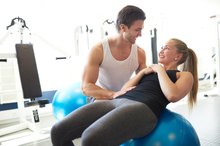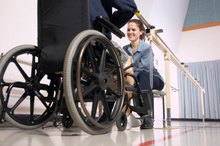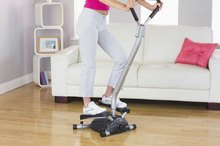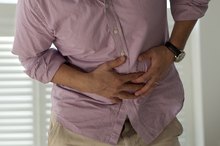Abdomen Inflamed Because of Physical Exercise
Abdominal inflammation can occur at any time — even during your daily exercise routine. It can become so extreme that it interferes with your workout, forcing you to stop early. Because of this, it is important to understand what can cause inflammation in the abdominal area and how it can be treated and prevented.
If you are experiencing serious medical symptoms, seek emergency treatment immediately.
Symptoms
Exercise-related abdominal inflammation can range in intensity from mild to severe. It can be accompanied by pain, bruising, warmth, redness and swelling. In addition, you can notice gastrointestinal symptoms such as:
- belching
- nausea
- bloating
- intestinal cramps
- stomach pain
- vomiting
- diarrhea
- stomach cramps
Inflammation and pain can be so extreme that you become unstable or lose some or all mobility during physical activity and exercise.
Causes
What Causes Stomach Swelling & Diarrhea?
Learn More
The abdominal area can become inflamed when internal organs, such as the stomach and spleen, bump in to each other during exercise 2. This can cause stretching of the connective tissues, resulting in inflammation and pain. The diaphragm’s connective tissues can also stretch, causing an abdominal stitch. Abdominal inflammation and pain can also occur when you breathe vigorously during exercise, which robs the muscles of oxygen. Exercise can also trigger gastrointestinal intestinal disturbances. In addition, sprains, strains, and overuse exercise injuries can result in abdominal inflammation and pain.
- The abdominal area can become inflamed when internal organs, such as the stomach and spleen, bump in to each other during exercise 2.
- This can cause stretching of the connective tissues, resulting in inflammation and pain.
Treatment Options
Treat exercise-related abdominal inflammation by breathing evenly during your workout. Force deep breaths by filling up your lungs and pushing your stomach outward with each inhalation. If inflammation and pain do not subside, take a break and rest. If you suspect a sprain or strain, wrap your waist with an elastic bandage to help reduce swelling and pain. If you also experience gastrointestinal side effects, take an antacid or medication containing bismuth subsalicylate to help treat symptoms.
- Treat exercise-related abdominal inflammation by breathing evenly during your workout.
- If you also experience gastrointestinal side effects, take an antacid or medication containing bismuth subsalicylate to help treat symptoms.
Prevention
Stomach Pain & Pilates
Learn More
To ensure that the abdominal muscles stay hydrated throughout your workout, drink a few cups of water about a half hour before you exercise. In addition, sip on a cup of water during your workout. Refrain from eating large meals two to four hours before your exercise routine. Warm up your abdominal muscles with side twists and bends. This will make your abdominal muscles more flexible, helping to prevent inflammation and injury during exercise.
- To ensure that the abdominal muscles stay hydrated throughout your workout, drink a few cups of water about a half hour before you exercise.
Related Articles
References
- The Merck Manuals Online Medical Library: Approach to Sports Injuries
- Military.com; How to Avoid Stomach Cramps When Running; Stew Smith
- Patterson JW, Dominique E. Acute Abdomen. [Updated 2019 Nov 1]. In: StatPearls [Internet]. Treasure Island (FL): StatPearls Publishing; 2020 Jan-. Available from: https://www.ncbi.nlm.nih.gov/books/NBK459328/
- Schachter H. Indigestion and Heartburn. In: Walker HK, Hall WD, Hurst JW, editors. Clinical Methods: The History, Physical, and Laboratory Examinations. 3rd edition. Boston: Butterworths; 1990. Chapter 83. Available from: https://www.ncbi.nlm.nih.gov/books/NBK409/
- Sherman R. Abdominal Pain. In: Walker HK, Hall WD, Hurst JW, editors. Clinical Methods: The History, Physical, and Laboratory Examinations. 3rd edition. Boston: Butterworths; 1990. Chapter 86. Available from: https://www.ncbi.nlm.nih.gov/books/NBK412/
- Shi XZ, Lin YM, Hegde S. Novel Insights Into the Mechanisms of Abdominal Pain in Obstructive Bowel Disorders. Front Integr Neurosci. 2018;12:23. Published 2018 Jun 8. doi:10.3389/fnint.2018.00023
- Velissaris D, Karanikolas M, Pantzaris N, et al. Acute Abdominal Pain Assessment in the Emergency Department: The Experience of a Greek University Hospital. J Clin Med Res. 2017;9(12):987–993. doi:10.14740/jocmr3206w
- Macaluso CR, Mcnamara RM. Evaluation and management of acute abdominal pain in the emergency department. Int J Gen Med. 2012;5:789-97. doi:10.2147/IJGM.S25936
- Heading RC. Prevalence of upper gastrointestinal symptoms in the general population: a systematic review. Scand J Gastroenterol Suppl. 1999;231:3–8.
- Lyon C, Clark DC. Diagnosis of acute abdominal pain in older patients. Am Fam Physician. 2006;74(9):1537–1544.
- Morino M, Pellegrino L, Castagna E, Farinella E, Mao P. Acute nonspecific abdominal pain: A randomized, controlled trial comparing early laparoscopy versus clinical observation. Ann Surg. 2006;244(6):881–888. doi:10.1097/01.sla.0000246886.80424.ad
Writer Bio
Rose Erickson has been a professional writer since 2010. She specializes in fitness, parenting, beauty, health, nutrition and saving money, and writes for several online publications including The Krazy Coupon Lady. She is also a novelist and a mother of three.









